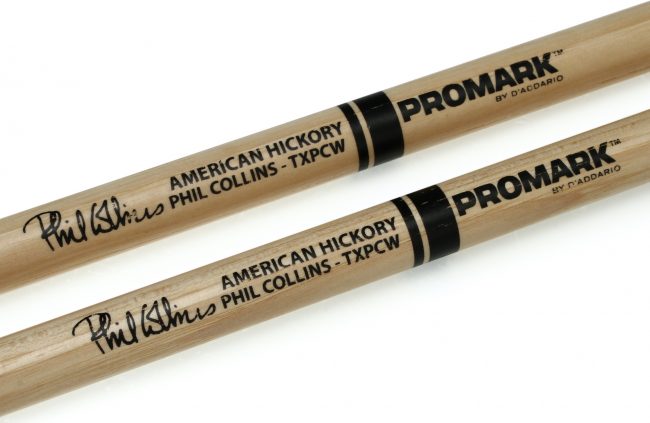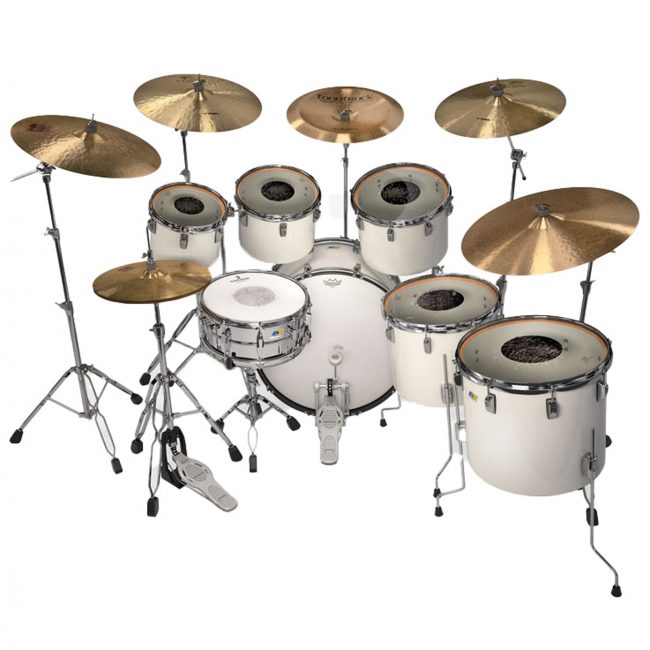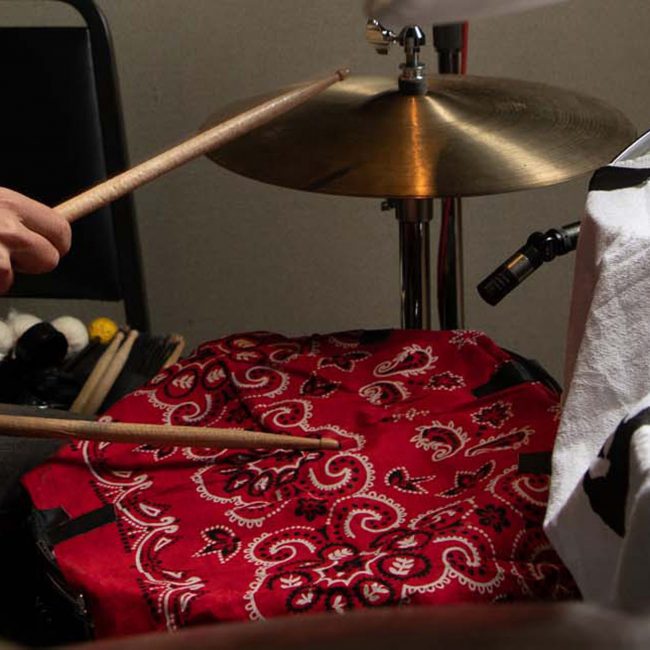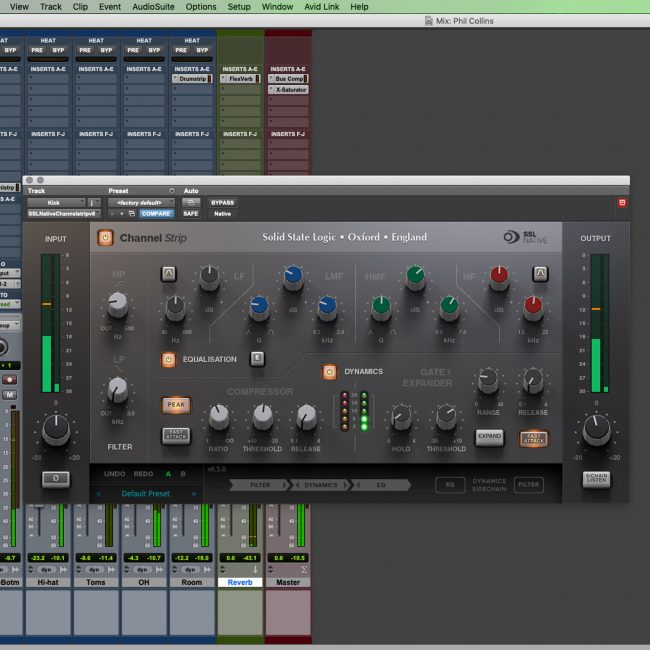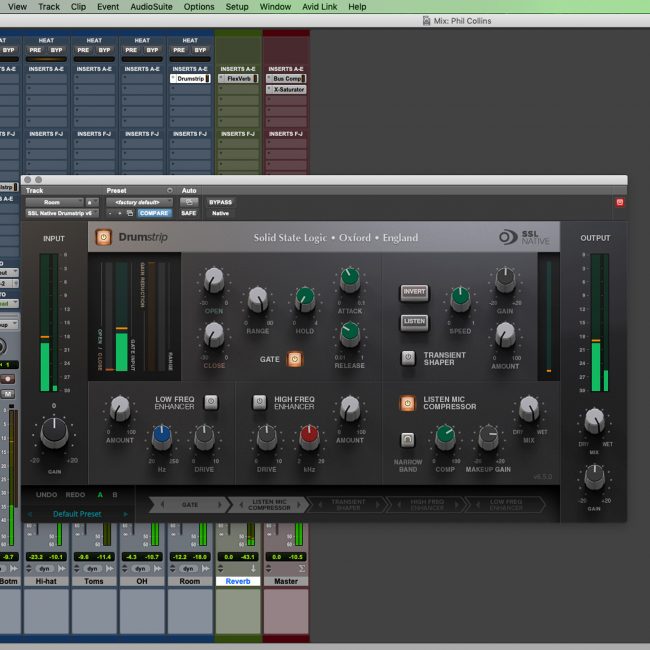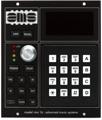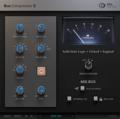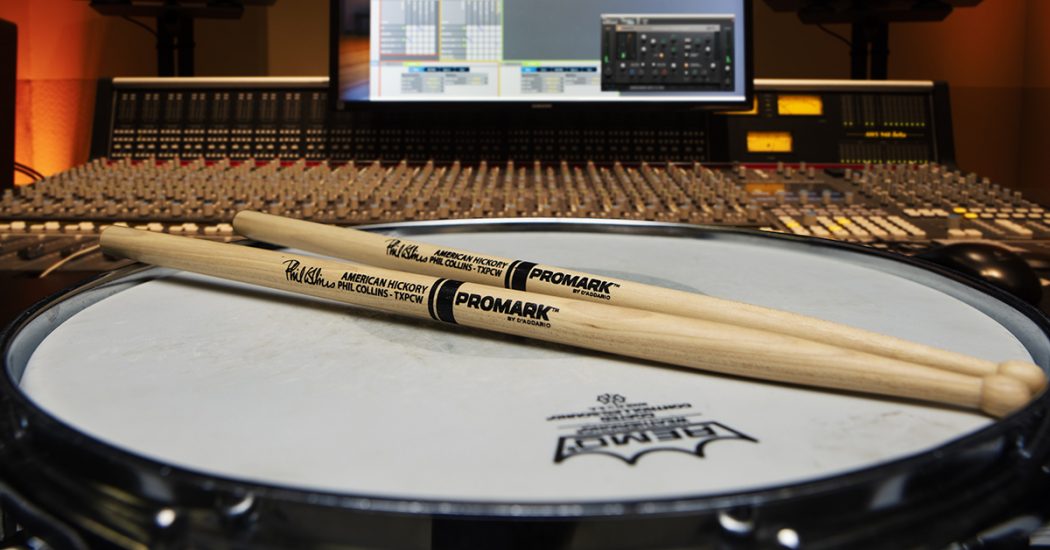
Of all the iconic drum sounds in rock history, the Phil Collins drum sound — particularly his 1980s-era sound — is among the most talked about. Many have aspired to re-create this sound using a gated reverb preset in their favorite plug-in or hardware unit. Unfortunately, this approach typically nets a wimpy, cheesy result — the epitome of the dreaded (and very dated) “bad ’80s gated snare” sound. So, how do you achieve the real-deal Phil Collins drum sound? Those unmistakable percussive textures that are brimming with muscle and presence? We’ll break it down for you.
The Acoustic Kit
Besides Phil himself, the most foundational aspect of the Phil Collins drum sound is his choice of drum kit. Phil has played Gretsch drums since 1983. Prior to that, he preferred Premier and Pearl drums. For example, he tracked his classic hit “In the Air Tonight” on a Premier 717 kit. Regardless of brand, Phil has always favored single-headed toms — one of the biggest contributors to his thunderous, in-your-face tom fills. In the studio, he is also known to dampen the batter head of his snare drum.
Phil’s gargantuan contemporary kit is built around a 20-inch kick; 18- and 16-inch floor toms; 15-, 12-, 10-, and 8-inch rack toms; and a 14-inch snare.
Phil employs a massive array of cymbals — typically Sabian — which includes 22- and 20-inch china cymbals; 16-, 18-, and 20-inch crashes; and 14-inch hi-hats.
The Electronics
Phil was an ardent proponent of — and early adopter of — electronic drums. He would frequently use drum machines to heighten the atmosphere of a song, a practice that began with “Duchess” off Genesis’s Duke in 1980, which featured a Roland CR-78 programmed to deliver a robotic, hypnotic beat. Later that year, Phil used the same CR-78 to conjure up an eerie ambience for “In the Air Tonight.”
Phil has also deployed Roland’s TR-808 and TR-909 (demonstrated on No Jacket Required‘s “One More Night” and “Take Me Home,” respectively) and has been known to integrate Simmons electronic drums into his acoustic kit — a sound that’s highlighted extensively on Genesis’s 1986 album, Invisible Touch.
The Studio
While the famous Phil Collins gated-reverb snare sound is often attributed to digital processing (indeed, the AMS Neve RMX16 digital reverberation system’s “NonLin 2” preset was crafted specifically for this purpose), the sound we hear on most of his songs is actually gated, extremely compressed room ambience. In the case of “In the Air Tonight,” the room was the small, highly reflective Studio 2 — a.k.a. “The Stone Room” — at Townhouse Studios in Shepherd’s Bush, London.
Built in 1978, Townhouse Studios hosted a who’s who of acclaimed artists including Elton John, Queen, Coldplay, Muse, Duran Duran, Oasis, Peter Gabriel, Kate Bush, and — of course — Phil Collins.
In 1992, the studios were absorbed by the EMI/Virgin Studio Group. In 2002, the studio was taken over by the Sanctuary Group. Unfortunately, Townhouse Studios closed its doors in 2008 and was converted into residential property — literal townhouses — in 2015.
The Gear
When Phil recorded at Townhouse in the eighties, the Stone Room housed an SSL 4000 B Series console — the second ever made. While the SSL’s features are commonplace in modern times, it was a cutting-edge desk when it first hit the industry, vaunting 32 channels with built-in, per-channel EQs, compressors, and noise gates as well as an onboard reverse talkback function, a.k.a. the Listen Mic, which included an integrated compressor designed to prevent overloads and to make quiet speech intelligible. The SSL console, combined with a lucky accident, is what produced the slammed-and-gated sound that we now associate with Phil’s 1980s material.
It was producers Hugh Padgham and Steve Lillywhite who stumbled upon the distinctive gated drum sound while they were working with Phil on Peter Gabriel’s third eponymous album. During a 2005 interview, Hugh Padgham recalled, “Phil was playing the drums and I had the reverse talkback on because he was speaking, and then he started playing the drums.” Hugh continued, “The most unbelievable sound came out because of the heavy compressor.”
That night, Hugh had the SSL modified so the output of the reverse talkback compressor — which wasn’t designed to be recorded — could be fed into one of the console’s channels. The signal was then passed through the channel’s in-line gate. It was at that moment that the gated drum sound was born.
Re-creating Phil’s Kit
If you combine the elements discussed above, then re-creating the Phil Collins drum sound is relatively straightforward.
I started by building a Phil Collins–inspired drum kit in Toontrack Superior Drummer 3. I’m including detailed information about the samples I used to make it easier for you to find something comparable if you use different drum software. Or, provided you’re a much better drummer than I am, you can record similarly spec’d real-world acoustic drums.
The kick and toms I used were culled from the Ludwig ’70s 3-ply Concert kit included with SD3:
- 28-inch kick with a Remo Ambassador Coated batter head and Ludwig WeatherMaster DB-1000 Heavy resonance head
- 14-, 12-, 10-, and 8-inch single-headed rack toms with Remo Controlled Sound Black Dot batter heads
- 18- and 16-inch floor toms with Remo Ambassador Coated batter heads and Ambassador Clear resonance heads
I used a 14-inch Ludwig 402 Supraphonic snare drum gleaned from Toontrack Decades SDX. The drum was captured with a Remo Controlled Sound Reverse Black Dot batter head and a Diplomat resonance head. The batter head was heavily dampened with a towel and gaffer tape.
I used a 15-inch Paiste 2002 Extra Heavy hi-hat pair.
Cymbals were as follows:
- 17-inch Paiste 2002 Medium crash
- 20-inch Paiste 2002 Medium crash/ride
- 10-inch Paiste 3000 splash
- 18-inch Paiste 2002 Medium crash
- 24-inch Paiste 2002 ride
- 18-inch Paiste 3000 Novo China
The drums were miked with the following:
- Kick — Sennheiser e 902 in; Neumann U 47 FET out
- Toms — Ehrlund EHR-E
- Snare — AKG D452 top; Shure SM57 bottom
- Hi-hat — Neumann KM 184
- Overheads — 2x Beyerdynamic M 201 TG
Everything was played with Vic Firth 5A American hickory drumsticks.
The Mix
This project was mixed in Avid Pro Tools Ultimate with HEAT engaged.
To begin with, I ran everything dry — just the close mics and overheads without including SD3’s ambient mics.
To duplicate the sound of The Stone Room, I ran the kick, snare, and toms through an impulse response captured at Townhouse Studios. This IR is included as a free download for Waves IR-series convolution reverb plug-in owners.
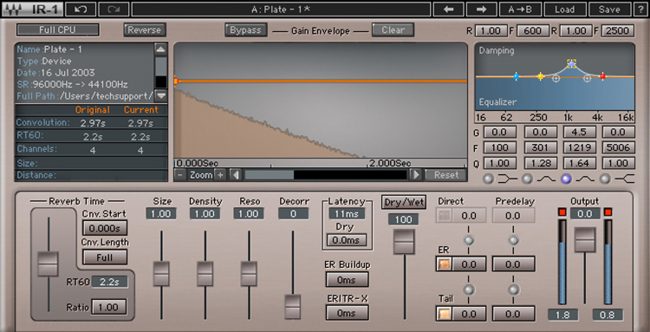
To emulate the sound of Townhouse Studios’ SSL 4000 B Series console, I employed several plug-ins from the Solid State Logic SSL Native Bundle.
I processed each component of the drum kit through an individual instance of SSL Channel Strip, leveraging the plug-in’s EQ, compression, and gating for added punch and definition. I also used SSL Channel Strip to tame the room’s boxy character as well as its muddy low midrange.
I then ran everything through the SSL G Series Bus Compressor with a 2:1 ratio and 1dB–2dB gain reduction as well as the SSL X-Saturator to inject everything with SSL-style analog character.
I also instantiated SSL FlexVerb on an aux send to add a bit of dimension to the hi-hats as they sounded dry compared to the rest of the kit.
Finally, I ran the drum room track through the SSL Drumstrip plug-in to replicate the SSL 4000 B’s reverse talkback microphone and gate. I deployed the plug-in’s Listen Mic Compressor aggressively, adjusted the gate for a relatively fast attack and release, then tweaked the gate’s other parameters until it sounded right.
Conclusion
So, there you have it — the fabled Phil Collins drum sound. And this is just a starting point. You can add as much compression and gated-room sound as you’d like for your own individual application.
Then, all you need to do is add a few ominous Prophet-5–style synth chords, CR-78–style drum machine accents, a hyper-processed electric guitar, and some well-placed vocoder-treated vocals, and you’ll be “In the Air Tonight.”
Questions? Give your Sales Engineer a call at (800) 222-4700. They’ll be happy to share their extensive knowledge with you.


